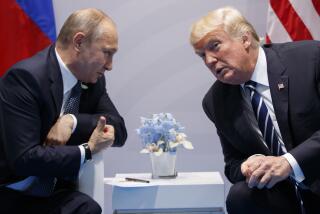‘Wag the Dog’ Unleashes Unreel View of U.S. Policy
- Share via
WASHINGTON — These days, American foreign policy faces, in a sense, two different worlds. One is the nice, fictitious world that was portrayed in the movie “Wag the Dog.” And the other is the much nastier reality we are beginning to see unfold in Russia.
“Wag the Dog” is, of course, on everyone’s mind, because of the U.S. missile strikes in Afghanistan and Sudan. The movie encapsulated, in advance, the most cynical possible interpretation of these events: In it, an American president goes to war in order to deflect attention from a sex scandal involving his affair with a young woman.
The movie has become a vehicle for discussion and jokes about President Clinton’s motives in launching the attack on terrorism just when his own personal troubles had peaked. So far, however, there has been little examination of the assumptions underlying both the movie and some of the recent talk about the anti-terrorist raids.
In the “Wag the Dog” world, the United States seems safe, prosperous and detached. If there are any threats on the horizon at all, they come only from small countries so remote and obscure that they don’t need to be taken seriously. In the movie itself, the diversionary war is with Albania.
And so, in a sense, “Wag the Dog” presents a Hollywood distortion of the foreign policy America confronts in the 1990s--just as many earlier movies (think of “The Hunt for Red October”) conveyed a distorted view of what the United States faced during the Cold War.
For decades, Americans believed they were on the verge of going to war against the Red Menace. Now, we assume that America is serenely secure, that the rest of the world is a bunch of Outer Slobovias, and that there can’t be any legitimate reason for American involvement overseas. If there’s a problem abroad, maybe somebody made it up, as in “Wag the Dog.”
The reality is otherwise. This country’s continuing prosperity is, to say the least, not guaranteed. America’s future depends on what happens overseas--not just in obscure countries, but in the same big ones that have counted throughout the last century, like Japan and China, Russia and Germany.
That brings us back to the recent events in Moscow. A week ago, amid Russia’s deepening financial crisis, Russian President Boris N. Yeltsin was compelled to open the way for the devaluation of the ruble and to suspend payment for 90 days on Russia’s debts.
Then, on Sunday, Yeltsin dismissed Sergei V. Kiriyenko, his prime minister for the last five months, and brought back Viktor S. Chernomyrdin, Kiriyenko’s predecessor. Kiriyenko had been seeking to impose a series of austerity measures and economic reforms; Chernomyrdin, by contrast, is allied with the industrial and business interests threatened by these measures.
Until recently, Russia’s problems have seemed remote and manageable. But now the situation seems to be deteriorating rapidly.
“There is a massive financial crisis coming in Russia, of an Indonesian type,” predicts Anders Aslund, a specialist on the Russian economy based at the Carnegie Endowment for International Peace. “What we have now is a worst-case scenario. Chernomyrdin is being brought back by the oligarchs to make sure there is no financial discipline.
” . . . There are no reserves to dip into, so Russia will start printing money. What I think will happen is hundreds of percent inflation in a year, a sharp fall in GDP [gross domestic product], runs on the banks and sharply falling exchange rates or an end to ruble convertibility. I find it difficult to see anything but a financial catastrophe,” Aslund says.
The Russian economy is already in lousy shape. If it suddenly becomes much worse, what will happen to the country’s political leadership and its foreign policy?
“You could see things in Russia that really overshadow our current international crises,” argues Dimitri Simes, president of the Nixon Center, a Washington-based foreign policy think tank. “Osama bin Laden is by himself not a fundamental challenge to American security. Try to imagine a regime in Russia that would support someone like that, or a regime that would paralyze any action by the U.N. Security Council. . . . These are scenarios I consider unlikely, but in the realm of possibility.”
Russia is hardly the only problem confronting the United States these days. As Americans return to work and school from summer vacations, the world’s economy looks considerably less promising than it did at this time last year.
One year ago today, the phrase “Asian financial crisis” had not yet appeared in any of the nation’s major newspapers. There seemed to be a small currency crisis in Thailand, but it had not spread anywhere else in Asia. Since then, economies have slumped and governments have fallen in South Korea, in Indonesia, even in Japan.
At the end of August 1997, Americans were remarkably cheery. “Poodle skirts aren’t back yet, but to hear it from incumbents, the happy, even carefree, circumstances of the Eisenhower era are: Profits are up. Unemployment is down,” wrote one New York Times reporter then, in an accurate portrayal of this nation’s mood at the time.
Who could be so optimistic now, as economists try to divine when the Asian financial crisis may finally come to an end and as ordinary Americans keep an eye on the stock market?
Some day, unfortunately, the movie “Wag the Dog” may come to be seen for what it really is--a period piece, about a brief moment in history when Americans believed that the only problems they faced abroad were feigned or imaginary.
Jim Mann’s column appears here on Wednesdays.
More to Read
Only good movies
Get the Indie Focus newsletter, Mark Olsen's weekly guide to the world of cinema.
You may occasionally receive promotional content from the Los Angeles Times.









